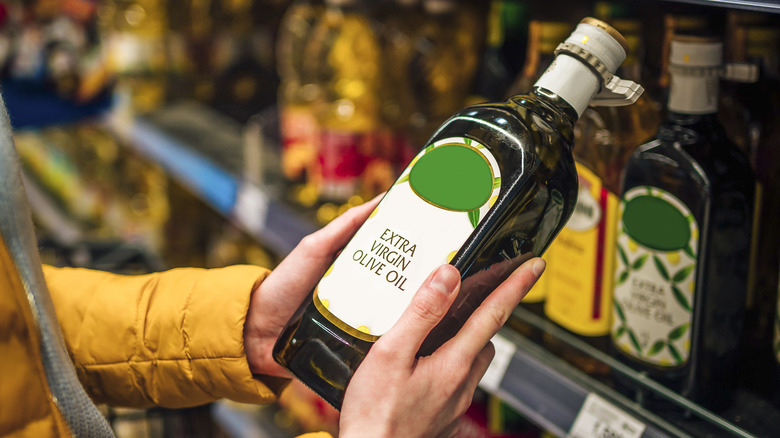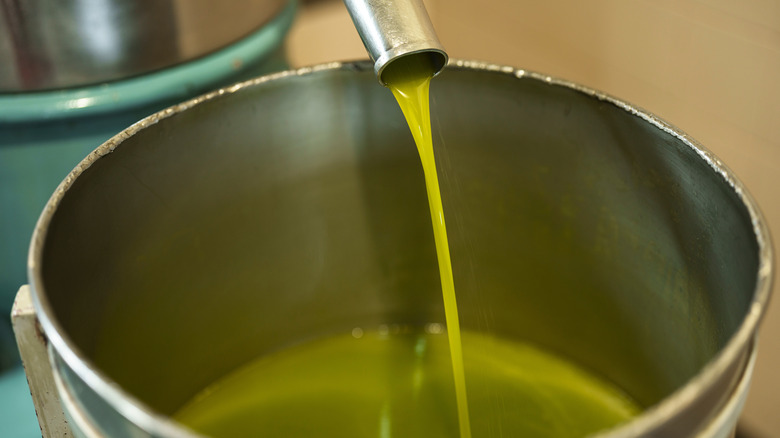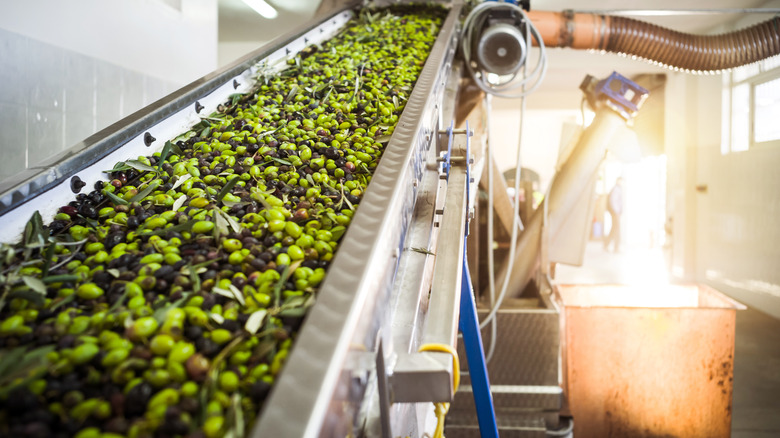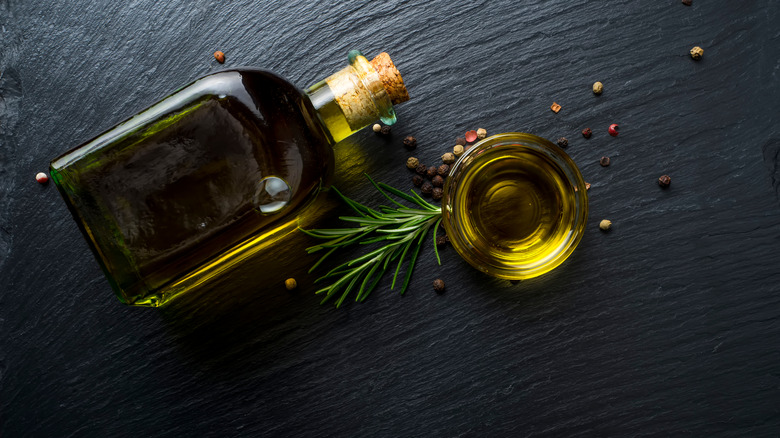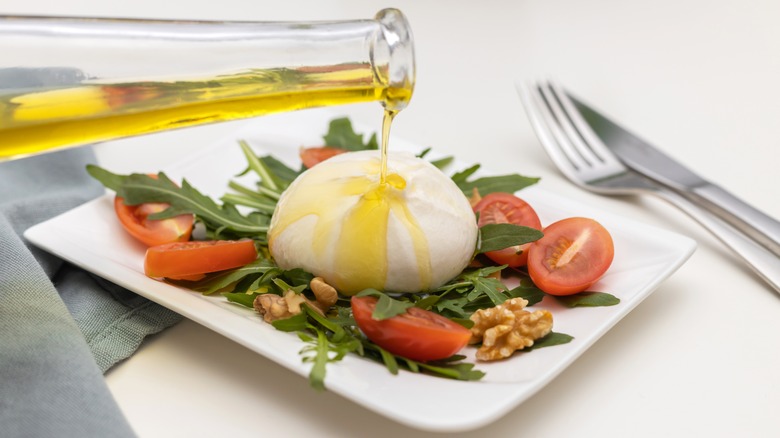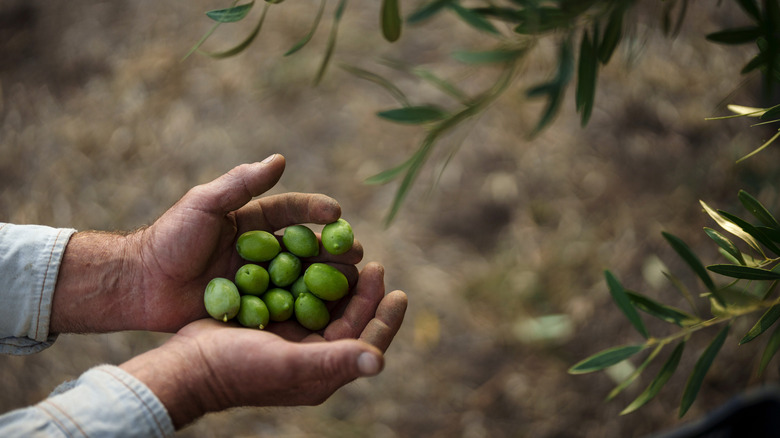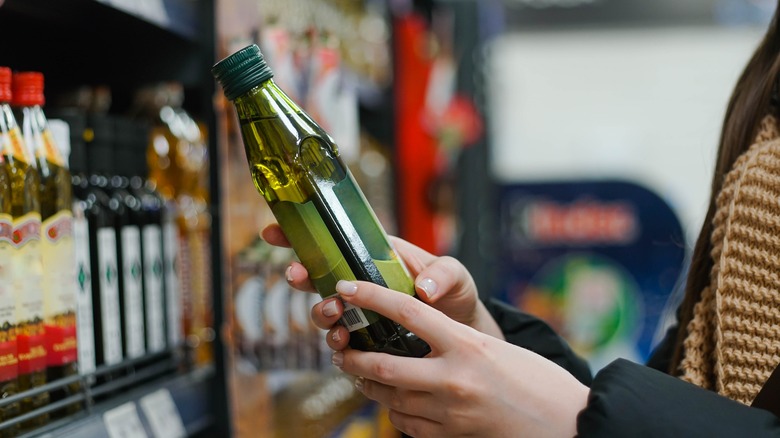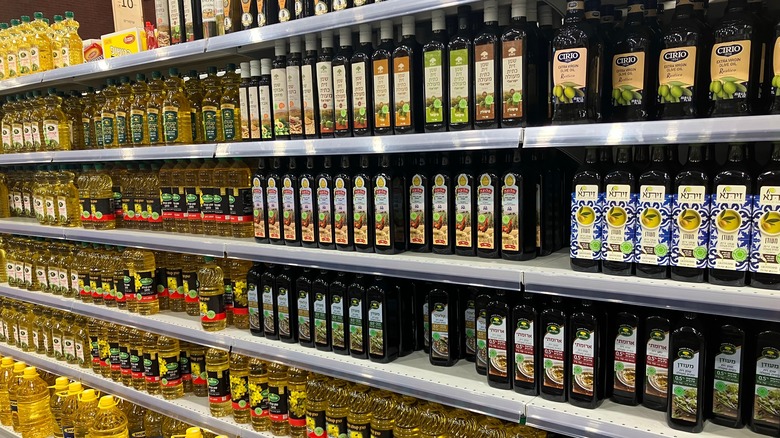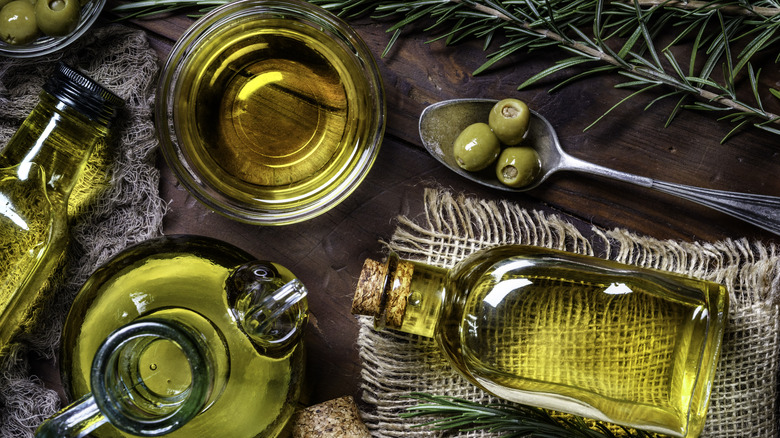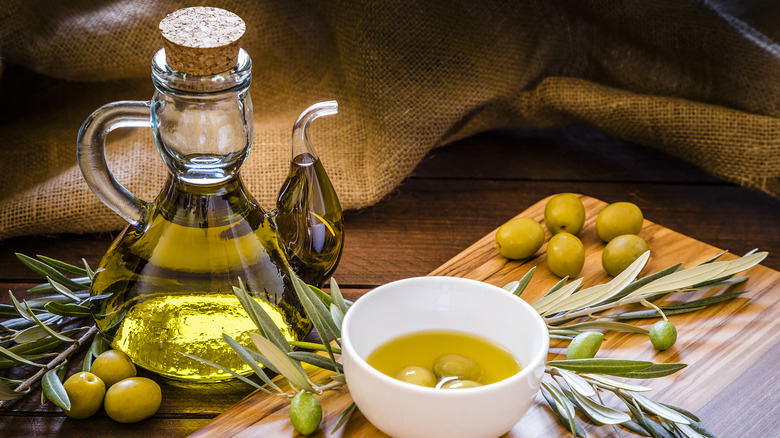The Ultimate Guide To Buying Olive Oil
Whether you prefer to cook with it, drizzle it on some crusty bread, use it to whip up a quick vinaigrette, or finish a hearty pasta dish, there's no denying that olive oil is one of the most versatile condiments on our pantry shelves. Used in ancient times for a sundry of different purposes — from medicine and soap to lamp fuel and cosmetics — this "liquid gold" now represents a $14.20 billion global industry with seemingly just as many different brands and types of oil to choose from, no matter your favored retailer.
With such an overwhelming selection at your fingertips, it's no wonder that something as simple as buying olive oil can be such a deceptively complex process. After all, what do the words "first cold-pressed" or "extra-virgin" really mean beyond the label? Does it really matter whether your oil of choice comes from Spain or Italy or Tunisia? Is there any reliable way to determine an olive oil's quality just from looking at the bottle or tin, without giving it a preliminary taste-test? Believe it or not, the answer to that last question is a resounding yes! We've scoured reports from professional gourmands and chefs, amassed every one of their tips, and poured them into this, our ultimate guide to buying olive oil. So the next time you're in the market for this tasty pantry staple, you'll know exactly what you're looking for.
Look for the least refined oil
Simply put, when it comes to quality olive oil, the less refinement the better. Terms such as extra-virgin, virgin, pure, premium, light-tasting, and so forth actually indicate the amount of refinement that has gone into a particular oil. Unsurprisingly, extra-virgin denotes the highest quality oil, one which is produced naturally — without any added heat or chemicals — and retains the highest amount of flavor as well as antioxidants from the original olives. Though extra-virgin is usually the go-to choice for this reason, there are also plenty of uses for olive oils that don't meet the extra-virgin standard, most commonly cooking and frying.
So-called virgin, plain, premium, classic, and pure olive oils are all designations for oils that have experienced too much refinement in their production process to meet the requirements for the "extra-virgin" label. In most cases, these oils have been cut with a small amount of higher-quality oil. However, the flavor profile will be considerably lighter (thus "light-tasting" olive oil) than a true batch of virgin or extra-virgin oil. Likewise, olive-pomace oil is a lesser-quality oil produced from the leftovers of the already-processed olive fruit. There are several organizations around the world that regulate the quality of olive oil according to their designating labels, including the European Union's Commission Implementing Regulation and the Department of Agriculture in the United States.
Cold pressed means higher quality
When you see terms like "first press" or "first cold-pressed" on your olive oil's label, you may be tempted to gloss over it as nothing more than a marketing term. After all, isn't all olive oil produced by pressing olive fruit? The answer is a tentative yes, though there is a distinct difference between olive oil produced from a standard expeller press and oil produced using the "cold-press" method. That difference lies largely in the amount of heat used in the overall process.
After the olives have been harvested and cleaned, the tiny fruit must still be crushed, milled, and pressed to release the aromatic oils within and separate said oil from any undesirable byproducts like pulp or water. The highest-quality oils are produced without ever exceeding the temperature of 27 degrees Celsius, or roughly 80 degrees Fahrenheit, thus the term "cold-pressed." Heat, whether added to speed up the production process or naturally accrued due to friction, can damage the resulting oil's nutritional properties as well as its flavor and aromatic qualities.
Be familiar with the flavor profile
When it comes to flavor profile, no two olive oils are quite the same. The taste of any given olive oil can range from pungent and peppery to nutty and buttery depending on a huge variety of factors. The particular breed of olive used to produce the oil, the region it was grown in, the weather over the course of the season, harvest time, and the production process all play a part in the resulting flavor profile of any given oil. That being said, a high-quality olive oil will almost always display a level of characteristic bitterness due to the presence of oleocanthal, a natural antioxidant that also influences the so-called peppery aspect of the oil's flavor.
Still, you're likely to come across more than a few flavored or infused oils featuring complimentary flavors such as garlic, citrus, any number of herbs, or even chili peppers. These gourmet oils largely follow the same labeling designations for quality as any other olive oil, though it should be noted that infusing typically involves heating the base oil along with any added aromatics. (In fact, it can make for a deliciously easy DIY project.) Extra-virgin olive oil infused with complimentary flavors can be used in exactly the same ways as olive oil that hasn't been infused, and can lend a refreshingly new aspect of taste to whatever dish, dressing, or marinade it's added to.
What about finishing oil?
Whether you prefer to spend your evenings binging cooking shows or not, you've likely heard the term "finishing oil" at least once in your lifetime — but, what exactly is a "finishing oil," and how is it any different from any other oil on the shelf? As per the name, "finishing" oils are used to drizzle on a dish before serving (or finish) rather than actually cooking it, with greater emphasis being placed on the oil's delicate flavor profile and how it may complement the rest of the dish's ingredients. Celebrity chefs from Martha Stewart to Gordon Ramsey devotedly use high-quality extra-virgin olive oils to finish their dishes.
Olive oils used for finishing dishes usually come in a smaller bottle than their multi-use counterparts and may be marketed for a specific flavor profile, such as fruitiness, pungency, or butteriness. A simple drizzle of a top-quality finishing olive oil is capable of livening up pretty much anything you care to throw together in the kitchen, from a perfectly grilled meat dish right up to a simple salad.
Does country of origin matter?
Olive oil of every quality is produced in dozens of different countries around the world, though some of the best-known remain the Mediterranean countries home to native species of olive trees, including Italy, Spain, Greece, and Tunisia. Spain, in particular, leads the world in terms of olive oil production, producing roughly 5.96 million tons of oil each year. In the United States, California is the top-producing state for olive oil, home to over 400 producers and 75 different varieties of olive trees.
But how does the country of origin affect the olive oil itself? Put plainly, where in the world a particular olive oil originates doesn't necessarily influence quality, but it can influence flavor and other characteristics. In Greece alone there are more than a few notable variations by region — for instance, oils from the island of Lesbos are known for a subtle sweetness in their flavor while many oils from the southern Peloponnese feature a strong peppery taste. Of course, it isn't just where the olives were grown that matter, but also when they were harvested and, for that matter, what species of olive contributed to the oil that will ultimately end up on your shelf. For this reason, many producers blend different monovarietal oils (oils produced from a single variety of olive) in order to achieve a desired flavor profile. So don't be put off if a particular bottle of oil lists more than a single country of origin.
Consider the costs
When it comes to olive oil, the old adage is mostly true: You really do get what you pay for. However, the number of factors affecting the prices of different olive oils goes beyond high and low quality. Of course, you're going to pay more for a relatively small bottle of cold-pressed monovarietal extra-virgin olive oil than you will for an average-sized bottle of Trader Giotto's blended EVOO. But you might be surprised to learn just how much things like weather and crop yield can impact the cost of a bottle of olive oil at your favored local grocer.
Take, for instance, the recent uptick in the price of Spanish olive oil. A prolonged drought, sky-high summer temps, water use restrictions imposed by the government, and a disruption in exports of Turkish oil have all contributed to the soaring price of Spanish olive oil, which just last month reached $8,900 per ton (via Forbes). As extreme weather continues to affect conditions in olive-growing regions around the world, so too will it continue to affect the global price of olive oil. That being said, it's still very possible to find a good oil at a reasonable price — but it may require a bit more selectivity than simply rolling up to the correct aisle and picking an attractive bottle. (Don't balk, we've all done it.)
Remember that packaging matters
Believe it or not, you don't have to taste a particular oil to get an idea of its quality — if you know what to look for, an oil's packaging should tell you everything you need to know. The bottle itself should be metal or opaque glass, usually dark green or amber in color so as to prevent the penetration of light, which can negatively impact the quality of the oil within. Plastic, though cheap and durable, is a less-than-ideal packaging material because of its porousness — unlike glass or metal, plastic could easily allow light, heat, and air to reach the oil and reduce its shelf life.
Beyond the actual packaging material, the next thing to look for is a harvest date (when the olives were picked), which is often displayed on the bottle alongside a best-by date. Ideally, any given oil that is stored properly should maintain quality until three years post-harvest date. However, not all producers print a harvest date on their bottles; this isn't necessarily a sign of poor quality. For oils that have been blended to produce a certain flavor profile, it may be impossible to print a single harvest date. Quality oils will also proudly display their country or countries of origin, and for oils from certain regions, you can look for a seal indicating a guarantee of quality. California's COOC (California Olive Oil Council) seal ensures that an oil has successfully met rigorous chemical and sensory standards before hitting the market.
Enjoy the healthy fats
As if you needed another reason to drizzle it on your favorite dish, olive oil is incredibly healthy. In ancient times, Hippocrates (of Hippocratic Oath fame) referred to it as "the great healer" and remarked on its medicinal properties. Today, modern medicine has found that despite containing a high amount of fatty acids, olive oil is packed with beneficial antioxidants and can aid in the prevention or treatment of inflammation, strokes, and heart disease. In fact, there is even evidence to suggest that sticking to a diet high in olive oil could contribute to weight loss.
To maximize your olive oil's health benefits, look for high-quality extra-virgin oils with zero trans fat. Olive oil is naturally devoid of trans fat, so if a nutritional label lists this health stat, chances are that the oil has been cut with a different hydrogenated oil and is not up to top quality.
Properly store your olive oil
Unlike wine, olive oil doesn't improve with age. On the contrary, it's usually wise to abide by a particular bottle's best-by date, and once opened, use the bottle within a matter of weeks or months at the longest. In the meantime, though, there are several things you can do to preserve the quality, flavor, and health benefits of your favorite olive oil of choice. First and foremost, keep the bottle in a cool, dark place away from the stove or any other appliances that might produce heat, which can ultimately cause olive oil to spoil. A shelf in a dark pantry is usually an ideal spot.
Of course, there is an argument for placing olive oil in one of the coolest and darkest places in your home: the refrigerator. When refrigerated, olive oil tends to cloud and solidify; while this doesn't impact flavor or health benefits, it does take some time for the oil to re-liquify once back at room temperature. Furthermore, after going through the process of repeatedly solidifying and thawing several times, olive oil will begin to break down and lose some of its more delicate flavors. For the most part, a dark space in a cool pantry is the way to go.
